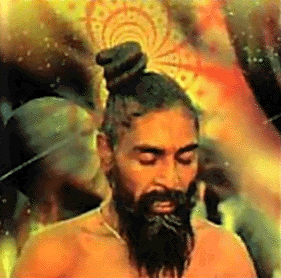
According to Dirghatamas Rig Veda I.155.6, "With four times ninety names (caturbhih sakam navatim ca namabhih), he (Vishnu) sets in motion moving forces like a turning wheel (cakra)." This suggests that even in Vedic times Vishnu had 360 names or forms, one for each degree of the zodiac. A fourfold division may correspond to the solstices and equinoxes. Elsewhere Dirghatamas states, I.164.36, "Seven half embryos form the seed of the world. They stand in the dharma by the direction of Vishnu." This probably refers to the seven planets.
Most of the astronomical information occurs in his famous Asya Vamasya Hymn I.164. Much of this hymn can be understood as a description of the zodiac. It begins:
1. Of this adorable old invoker (the Sun) is a middle brother who is pervasive (the Wind or lightning). He has a third brother, whose back carries ghee (Fire). There I saw the Lord of the people (the Sun) who has seven children.
This verse is referring to the usual threefold Vedic division of Gods and worlds as the Fire (Agni) on Earth, the Wind or Lightning (Vayu) in the Atmosphere and the Sun (Surya) in Heaven. This also may refer to the three steps or strides of Vishnu through which he measures the Earth, the Atmosphere and Heaven. The Sun is also a symbol of the supreme light or the supreme Sun God that is Vishnu. The Sun or supreme light has seven children, the visible Sun, Moon and five planets.We should note that the zodiac of twelve signs is divided into three sections based upon a similar understanding, starting with Aries or fire (cardinal fire ruled by Mars, who in Vedic thought is the fire born of the Earth), then with Leo or the Sun (fixed fire ruled by the Sun), and then with Sagittarius, the atmospheric fire, lightning or wind (mutable fire ruled by Jupiter, the God of the rains).
2. Seven yoke the chariot that has a single wheel (chakra). One horse that has seven names carries it. The wheel has three naves, is undecaying and never overcome, where all these beings are placed.
3. This chariot which the seven have mounted has seven wheels (chakras) and is carried by seven horses. The seven sisters sing forth together, where are hidden the seven names of the cows.
11. The wheel of law with twelve spokes does not decay as it revolves around heaven. Oh Fire, here your 720 sons abide.
12. The Father with five feet and twelve forms, they say, dwells in the higher half of heaven full of waters. Others say that he is the clear-seeing one who dwells below in a sevenfold wheel that has six spokes.
The sevenfold wheel is the zodiac moved by the seven planets. The six spokes are the six double signs through which the planets travel. The same verse occurs in the Prashna Upanishad I.11 as a symbol for the year.
13. Revolving on this five-spoked wheel all beings stand. Though it carries a heavy load, its axle does not over heat. From of old it does not break its ancient laws.
14. The undecaying wheel (circle) together with its felly (circumference), ten yoked to the upward extension carry it. The eye of the Sun moves encompassing the region. In it are placed all beings.
15. Of those that are born together, the seventh is born alone. The six are twins (yama), Divine born rishis. The wishes that they grant are apportioned according to their nature. Diversely made for their ordainer, they move in different forms.
The planets are often associated with the rishis in Vedic thought, particularly the rishis Brihaspati (Jupiter), Shukra (Venus) and Kashyapa (the Sun) which became common names for the planets. Their ordainer or stabilizer may be the pole star (polar point).




0 comments:
Post a Comment